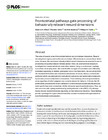Frontostriatal pathways gate processing of behaviorally relevant reward dimensions
dc.contributor.author
Weber, Susanna C.
dc.contributor.author
Kahnt, Thorsten
dc.contributor.author
Quednow, Boris B.
dc.contributor.author
Tobler, Philippe N.
dc.date.accessioned
2019-03-21T12:34:04Z
dc.date.available
2018-11-09T05:56:46Z
dc.date.available
2018-11-27T15:03:08Z
dc.date.available
2018-11-27T15:04:01Z
dc.date.available
2019-03-21T12:34:04Z
dc.date.issued
2018-10
dc.identifier.issn
1544-9173
dc.identifier.issn
1545-7885
dc.identifier.other
10.1371/journal.pbio.2005722
en_US
dc.identifier.uri
http://hdl.handle.net/20.500.11850/302517
dc.identifier.doi
10.3929/ethz-b-000302517
dc.description.abstract
The value of rewards arises from multiple hedonic and motivational dimensions. Reward-encoding brain regions such as the ventral striatum (VS) are known to process these dimensions. However, the mechanism whereby distinct reward dimensions are selected for neural processing and guiding behavior remains unclear. Here, we used functional imaging to investigate how human individuals make either hedonic (liking) or motivational (wanting) evaluations of everyday items. We found that the two types of evaluations were differently modulated depending on whether participants won or lost these items. Neural activity in the VS encoded both hedonic and motivational dimensions of reward, whereas ventromedial prefrontal activity encoded primarily motivational evaluations and central orbitofrontal activity encoded predominantly hedonic evaluations. These distinct prefrontal representations arose regardless of which judgment was currently relevant for behavior. Critically, the VS preferentially processed the reward dimension currently being evaluated and showed judgment-specific functional connectivity with the dimension-specific prefrontal areas. Thus, our data are in line with a gating mechanism by which prefrontal cortex (PFC)–VS pathways flexibly encode reward dimensions depending on their behavioral relevance. These findings provide a prototype for a generalized information selection mechanism through content-tailored frontostriatal communication.
en_US
dc.format
application/pdf
en_US
dc.language.iso
en
en_US
dc.publisher
PLOS
dc.rights.uri
http://creativecommons.org/licenses/by/4.0/
dc.title
Frontostriatal pathways gate processing of behaviorally relevant reward dimensions
en_US
dc.type
Journal Article
dc.rights.license
Creative Commons Attribution 4.0 International
dc.date.published
2018-10-19
ethz.journal.title
PLoS Biology
ethz.journal.volume
16
en_US
ethz.journal.issue
10
en_US
ethz.journal.abbreviated
PLoS biol.
ethz.pages.start
e2005722
en_US
ethz.size
19 p.
en_US
ethz.version.deposit
publishedVersion
en_US
ethz.identifier.wos
ethz.identifier.scopus
ethz.publication.place
Lawrence, KS
ethz.publication.status
published
en_US
ethz.date.deposited
2018-11-09T05:56:47Z
ethz.source
SCOPUS
ethz.eth
yes
en_US
ethz.availability
Open access
en_US
ethz.rosetta.installDate
2018-11-27T15:03:11Z
ethz.rosetta.lastUpdated
2024-02-02T07:22:47Z
ethz.rosetta.versionExported
true
ethz.COinS
ctx_ver=Z39.88-2004&rft_val_fmt=info:ofi/fmt:kev:mtx:journal&rft.atitle=Frontostriatal%20pathways%20gate%20processing%20of%20behaviorally%20relevant%20reward%20dimensions&rft.jtitle=PLoS%20Biology&rft.date=2018-10&rft.volume=16&rft.issue=10&rft.spage=e2005722&rft.issn=1544-9173&1545-7885&rft.au=Weber,%20Susanna%20C.&Kahnt,%20Thorsten&Quednow,%20Boris%20B.&Tobler,%20Philippe%20N.&rft.genre=article&rft_id=info:doi/10.1371/journal.pbio.2005722&
Dateien zu diesem Eintrag
Publikationstyp
-
Journal Article [128892]

